Makran Subduction Zone: A Review and Synthesis
Abstract
1. Introduction
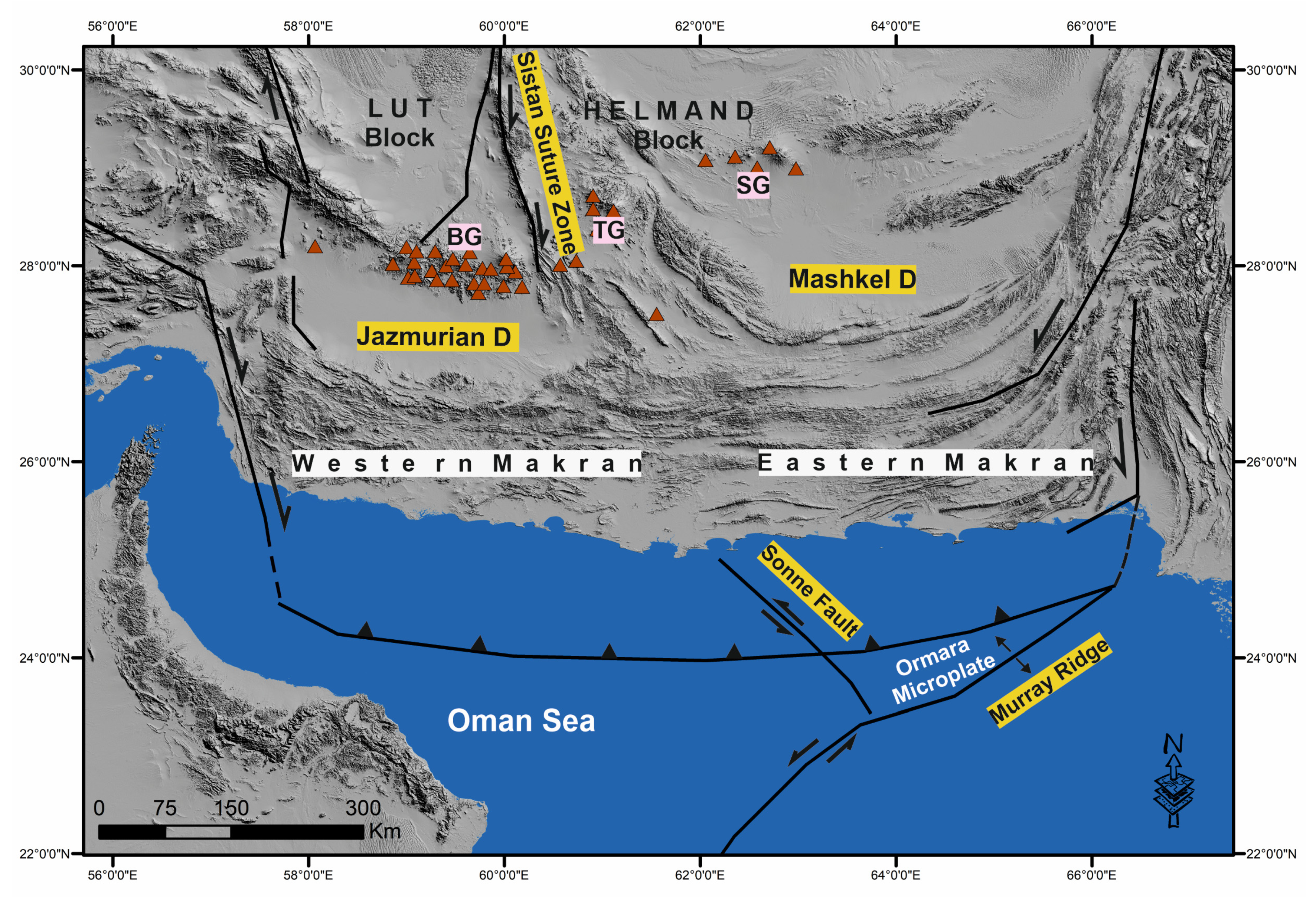
2. Tectonic Setting
3. Seismicity
4. Coastal Uplift
5. GPS, Velocity Vectors, and Coupling
6. Makran and Lut Block
7. Subduction Angle
8. Conclusions and Suggestions
Author Contributions
Funding
Data Availability Statement
Acknowledgments
Conflicts of Interest
References
- Kopp, C.; Fruehn, J.; Flueh, E.; Reichert, C.; Kukowski, N.; Bialas, J.; Klaeschen, D. Structure of the Makran subduction zone from wide-angle and reflection seismic data. Tectonophysics 2000, 329, 171–191. [Google Scholar] [CrossRef]
- Kukowski, N.; Schillhorn, T.; Flueh, E.R.; Huhn, K. Newly identified strike-slip plate boundary in the northeastern Arabian Sea. Geology 2000, 28, 355–358. [Google Scholar] [CrossRef]
- Grando, G.; McClay, K. Morphotectonics domains and structural styles in the Makran accretionary prism, offshore Iran. Sediment. Geol. 2007, 196, 157–179. [Google Scholar] [CrossRef]
- Burg, J.-P.; Dolati, A.; Bernoulli, D.; Smit, J. Structural style of the Makran Tertiary accretionary complex in SE-Iran. In Lithosphere Dynamics and Sedimentary Basins: The Arabian Plate and Analogues; Springer: Berlin/Heidelberg, Germany, 2013. [Google Scholar]
- Berberian, M.; Jackson, J.; Qorashi, M.; Talebian, M.; Khatib, M.; Priestley, K. The 1994 Sefidabeh earthquakes in eastern Iran: Blind thrusting and bedding-plane slip on a growing anticline, and active tectonics of the Sistan suture zone. Geophys. J. Int. 2000, 142, 283–299. [Google Scholar] [CrossRef]
- Berberian, M.; Jackson, J.; Fielding, E.; Parsons, B.; Priestley, K.; Qorashi, M.; Talebian, M.; Walker, R.; Wright, T.; Baker, C. The 1998 March 14 Fandoqa earthquake (Mw 6.6) in Kerman province, southeast Iran: Re-rupture of the 1981 Sirch earthquake fault, triggering of slip on adjacent thrusts and the active tectonics of the Gowk fault zone. Geophys. J. Int. 2001, 146, 371–398. [Google Scholar] [CrossRef]
- Tirrul, R.; Bell, I.; Griffis, R.; Camp, V. The Sistan suture zone of eastern Iran. Geol. Soc. Am. Bull. 1983, 94, 134–150. [Google Scholar] [CrossRef]
- Nemati, M. Seismotectonic and seismicity of Makran, a bimodal subduction zone, SE Iran. J. Asian Earth Sci. 2019, 169, 139–161. [Google Scholar] [CrossRef]
- Platt, J.P.; Leggett, J.K.; Alam, S. Slip vectors and fault mechanics in the Makran accretionary wedge, southwest Pakistan. J. Geophys. Res. Solid Earth 1988, 93, 7955–7973. [Google Scholar] [CrossRef]
- Byrne, D.E.; Sykes, L.R.; Davis, D.M. Great thrust earthquakes and aseismic slip along the plate boundary of the Makran subduction zone. J. Geophys. Res. Solid Earth 1992, 97, 449–478. [Google Scholar] [CrossRef]
- McCall, G.; Kidd, R. The Makran, Southeastern Iran: The anatomy of a convergent plate margin active from Cretaceous to Present. Geol. Soc. Lond. Spec. Publ. 1982, 10, 387–397. [Google Scholar] [CrossRef]
- McCall, G. Ophiolitic and Related Mélanges: Benchmark Papers in Geology/66; Hutchinson Ross Publishing Company: Stroudsburg, PA, USA, 1983; p. xii. [Google Scholar]
- McCall, G. The geotectonic history of the Makran and adjacent areas of southern Iran. J. Asian Earth Sci. 1997, 15, 517–531. [Google Scholar] [CrossRef]
- McCall, G.J. A summary of the geology of the Iranian Makran. Geol. Soc. Lond. Spec. Publ. 2002, 195, 147–204. [Google Scholar] [CrossRef]
- Jacob, K.H.; Quitmeyer, R.; Farah, A.; DeJong, K. The Makran region of Pakistan and Iran: Trench-arc system with active plate subduction. Quittmeyer Richard Charles. In Geodynamics of Pakistan; Farah, A., de Jong, K.A., Eds.; Quetta Geological Survey of Pakistan: Quetta, Pakistan, 1979; pp. 305–317. [Google Scholar]
- Zarifi, Z. Unusual Subduction Zones: Case Studies in Colombia and Iran. Ph.D. Thesis, Faculty of Mathematics and Natural Sciences, The University of Bergen, Bergen, Norway, 2007. Available online: https://bora.uib.no/bora-xmlui/handle/1956/2317 (accessed on 15 June 2024).
- Musson, R. Subduction in the Western Makran: The historian’s contribution. J. Geol. Soc. 2009, 166, 387–391. [Google Scholar] [CrossRef]
- Rajendran, C.; Rajendran, K.; Shah-Hosseini, M.; Beni, A.N.; Nautiyal, C.M.; Andrews, R. The hazard potential of the western segment of the Makran subduction zone, northern Arabian Sea. Nat. Hazards 2013, 65, 219–239. [Google Scholar] [CrossRef]
- Smith, G.L.; McNeill, L.C.; Wang, K.; He, J.; Henstock, T.J. Thermal structure and megathrust seismogenic potential of the Makran subduction zone. Geophys. Res. Lett. 2013, 40, 1528–1533. [Google Scholar] [CrossRef]
- Khaledzadeh, M.; Ghods, A. Estimation of size of megathrust zone in the Makran subduction system by thermal modelling. Geophys. J. Int. 2022, 228, 1530–1540. [Google Scholar] [CrossRef]
- Penney, C.; Tavakoli, F.; Saadat, A.; Nankali, H.R.; Sedighi, M.; Khorrami, F.; Sobouti, F.; Rafi, Z.; Copley, A.; Jackson, J. Megathrust and accretionary wedge properties and behaviour in the Makran subduction zone. Geophys. J. Int. 2017, 209, 1800–1830. [Google Scholar] [CrossRef]
- Khorrami, F.; Vernant, P.; Masson, F.; Nilfouroushan, F.; Mousavi, Z.; Nankali, H.; Saadat, S.A.; Walpersdorf, A.; Hosseini, S.; Tavakoli, P. An up-to-date crustal deformation map of Iran using integrated campaign-mode and permanent GPS velocities. Geophys. J. Int. 2019, 217, 832–843. [Google Scholar] [CrossRef]
- Ghadimi, H.; Khodaverdian, A.; Zafarani, H. Active deformation in the Makran region using geological, geodetic and stress direction data sets. Geophys. J. Int. 2023, 235, 2556–2580. [Google Scholar] [CrossRef]
- Cheng, G.; Barnhart, W.D.; Small, D. Constraints from GPS measurements on plate-coupling within the Makran Subduction Zone and tsunami scenarios in the Western Indian Ocean. Geophys. J. Int. 2024, 237, 288–301. [Google Scholar] [CrossRef]
- Lin, Y.; Jolivet, R.; Simons, M.; Agram, P.; Martens, H.R.; Li, Z.; Lodi, S. High interseismic coupling in the Eastern Makran (Pakistan) subduction zone. Earth Planet. Sci. Lett. 2015, 420, 116–126. [Google Scholar] [CrossRef]
- Ghods, A.; Bergman, E.; Akbarzadeh Aghdam, M.; Khaledzadehi, M. The Geometry of Makran Subducting Plate as Inferred from Relocated Seismicity Map. In Proceedings of the 9th International Conference on Seismology and Earthquake Engineering, Tehran, Iran, 9 May 2024. [Google Scholar]
- Lv, X.; Amelung, F.; Shao, Y. Widespread aseismic slip along the Makran megathrust triggered by the 2013 Mw 7.7 Balochistan earthquake. Geophys. Res. Lett. 2022, 49, e2021GL097411. [Google Scholar] [CrossRef]
- Akbarzadeh Aghdam, M.; Ghods, A.; Sobouti, F.; Motaghi, K.; Priestley, K.; Enayat, M. Seismicity around the boundary between eastern and western Makran. J. Asian Earth Sci. 2024, 259, 105926. [Google Scholar] [CrossRef]
- Little, R. Terraces of the Makran coast of Iran. In Physical Geography of the Makran Coastal Plain of Iran; University of New Mexico: Albuquerque, NM, USA, 1970; pp. 318–372. [Google Scholar]
- Page, W.D.; Alt, J.N.; Cluff, L.S.; Plafker, G. Evidence for the recurrence of large-magnitude earthquakes along the Makran coast of Iran and Pakistan. Tectonophysics 1979, 52, 533–547. [Google Scholar] [CrossRef]
- Vita-Finzi, C.; Ambraseys, N.N.; Melville, C.P. A History of Persian Earthquakes; Cambridge Earth Science Series; Cambridge University Press: Cambridge, UK, 1982. [Google Scholar]
- Reyss, J.; Pirazzoli, P.; Haghipour, A.; Hatte, C.; Fontugne, M. Quaternary marine terraces and tectonic uplift rates on the south coast of Iran. Geol. Soc. Lond. Spec. Publ. 1999, 146, 225–237. [Google Scholar] [CrossRef]
- Vita-Finzi, C. Neotectonics at the Arabian plate margins. J. Struct. Geol. 2001, 23, 521–530. [Google Scholar] [CrossRef]
- Snead, R.J. Uplifted marine terraces along the Makran coast of Pakistan and Iran. In Himalaya to the theSea; Routledge: London, UK, 1993; pp. 225–246. [Google Scholar]
- Normand, R.; Simpson, G.; Bahroudi, A. Pleistocene coastal evolution in the Makran subduction zone. Front. Earth Sci. 2019, 7, 186. [Google Scholar] [CrossRef]
- Normand, R.; Simpson, G.; Bahroudi, A. Extension at the coast of the Makran subduction zone (Iran). Terra Nova 2019, 31, 503–510. [Google Scholar] [CrossRef]
- Normand, R.; Simpson, G.; Herman, F.; Biswas, R.H.; Bahroudi, A.; Schneider, B. Dating and morpho-stratigraphy of uplifted marine terraces in the Makran subduction zone (Iran). Earth Surf. Dyn. 2019, 7, 321–344. [Google Scholar] [CrossRef]
- Gharibreza, M. Evolutionary trend of paleoshorelines in the Coastal Makran zone (Southeast Iran) since the mid-Holocene. Quat. Int. 2016, 392, 203–212. [Google Scholar] [CrossRef]
- Haghipour, N.; Burg, J.-P.; Ivy-Ochs, S.; Hajdas, I.; Kubik, P.; Christl, M. Correlation of fluvial terraces and temporal steady-state incision on the onshore Makran accretionary wedge in southeastern Iran: Insight from channel profiles and 10Be exposure dating of strath terraces. Bulletin 2015, 127, 560–583. [Google Scholar] [CrossRef]
- Nilforoushan, F.; Masson, F.; Vernant, P.; Vigny, C.; Martinod, J.; Abbassi, M.; Nankali, H.; Hatzfeld, D.; Bayer, R.; Tavakoli, F. GPS network monitors the Arabia-Eurasia collision deformation in Iran. J. Geod. 2003, 77, 411–422. [Google Scholar] [CrossRef]
- Vernant, P.; Nilforoushan, F.; Hatzfeld, D.; Abbassi, M.; Vigny, C.; Masson, F.; Nankali, H.; Martinod, J.; Ashtiani, A.; Bayer, R. Present-day crustal deformation and plate kinematics in the Middle East constrained by GPS measurements in Iran and northern Oman. Geophys. J. Int. 2004, 157, 381–398. [Google Scholar] [CrossRef]
- Apel, E.; Bürgmann, R.; Banerjee, P.; Nagarajan, B. Geodetically Constrained Indian Plate Motion and Implications for Plate Boundary Deformation; AGU Fall Meeting Abstracts: Washington, DC, USA, 2006. [Google Scholar]
- Bayer, R.; Chery, J.; Tatar, M.; Vernant, P.; Abbassi, M.; Masson, F.; Nilforoushan, F.; Doerflinger, E.; Regard, V.; Bellier, O. Active deformation in Zagros—Makran transition zone inferred from GPS measurements. Geophys. J. Int. 2006, 165, 373–381. [Google Scholar] [CrossRef]
- Masson, F.; Anvari, M.; Djamour, Y.; Walpersdorf, A.; Tavakoli, F.; Daignieres, M.; Nankali, H.; Van Gorp, S. Large-scale velocity field and strain tensor in Iran inferred from GPS measurements: New insight for the present-day deformation pattern within NE Iran. Geophys. J. Int. 2007, 170, 436–440. [Google Scholar] [CrossRef]
- Frohling, E.; Szeliga, W. GPS constraints on interplate locking within the Makran subduction zone. Geophys. Suppl. Mon. Not. R. Astron. Soc. 2016, 205, 67–76. [Google Scholar] [CrossRef]
- Palano, M.; Imprescia, P.; Agnon, A.; Gresta, S. An improved evaluation of the seismic/geodetic deformation-rate ratio for the Zagros Fold-and-Thrust collisional belt. Geophys. J. Int. 2018, 213, 194–209. [Google Scholar] [CrossRef]
- Gripp, A.E.; Gordon, R.G. Current plate velocities relative to the hotspots incorporating the NUVEL-1 global plate motion model. Geophys. Res. Lett. 1990, 17, 1109–1112. [Google Scholar] [CrossRef]
- Argus, D.F.; Gordon, R.G. No-net-rotation model of current plate velocities incorporating plate motion model NUVEL-1. Geophys. Res. Lett. 1991, 18, 2039–2042. [Google Scholar] [CrossRef]
- DeMets, C.; Gordon, R.G.; Argus, D.F.; Stein, S. Effect of recent revisions to the geomagnetic reversal time scale on estimates of current plate motions. Geophys. Res. Lett. 1994, 21, 2191–2194. [Google Scholar] [CrossRef]
- Drewes, H. Combination of VLBI, SLR and GPS determined station velocities for actual plate kinematic and crustal deformation models. In Geodesy on the Move: Gravity, Geoid, Geodynamics and Antarctica; Springer: Berlin/Heidelberg, Germany, 1998; pp. 377–382. [Google Scholar]
- Drewes, H.; Angermann, D. The actual plate kinematic and crustal deformation model 2000 (APKIM 2000) as a geodetic reference system. In Proceedings of the IAG 2001 Scientific Assembly, Budapest, Hungary, 2–7 September 2001. [Google Scholar]
- Sella, G.F.; Dixon, T.H.; Mao, A. REVEL: A model for recent plate velocities from space geodesy. J. Geophys. Res. Solid Earth 2002, 107, ETG 11-1–ETG 11-30. [Google Scholar] [CrossRef]
- Kreemer, C.; Holt, W.E.; Haines, A.J. An integrated global model of present-day plate motions and plate boundary deformation. Geophys. J. Int. 2003, 154, 8–34. [Google Scholar] [CrossRef]
- Prawirodirdjo, L.; Bock, Y. Instantaneous global plate motion model from 12 years of continuous GPS observations. J. Geophys. Res. Solid Earth 2004, 109, B8. [Google Scholar] [CrossRef]
- Drewes, H. The actual plate kinematic and crustal deformation model APKIM2005 as basis for a non-rotating ITRF. In Proceedings of the Geodetic Reference Frames: IAG Symposium, Munich, Germany, 9–14 October 2006; pp. 95–99. [Google Scholar]
- Argus, D.F.; Gordon, R.G.; Heflin, M.B.; Ma, C.; Eanes, R.J.; Willis, P.; Peltier, W.R.; Owen, S.E. The angular velocities of the plates and the velocity of Earth’s centre from space geodesy. Geophys. J. Int. 2010, 180, 913–960. [Google Scholar] [CrossRef]
- DeMets, C.; Gordon, R.G.; Argus, D.F. Geologically current plate motions. Geophys. J. Int. 2010, 181, 1–80. [Google Scholar] [CrossRef]
- Abbasi, M.; Ghods, A.; Najafi, M.; Abbasy, S.; Amiri, M.; Shabanian, E.; Kheradmandi, M.; Asgari, J. Why does western Makran have a low seismicity rate? Tectonophysics 2023, 869, 230134. [Google Scholar] [CrossRef]
- Engdahl, E.R.; Villaseñor, A. Global Seismicity: 1900–1999. In International Geophysics; Elsevier: Amsterdam, The Netherlands, 2002; Volume 81, pp. 665–690. [Google Scholar]
- Motaghi, K.; Shabanian, E.; Nozad-Khalil, T. Deep structure of the western coast of the Makran subduction zone, SE Iran. Tectonophysics 2020, 776, 228314. [Google Scholar] [CrossRef]
- Priestley, K.; Sobouti, F.; Mokhtarzadeh, R.; Irandoust, M.A.; Ghods, R.; Motaghi, K.; Ho, T. New constraints for the on-shore Makran Subduction Zone crustal structure. J. Geophys. Res. Solid Earth 2022, 127, e2021JB022942. [Google Scholar] [CrossRef]
- Mousavi, N.; Ardestani, V.E.; Moosavi, N. Slab extension and normal faulting in a low-angle subduction-related environment: An example of the Makran subduction zone (Iran–Pakistan). J. Asian Earth Sci. 2022, 233, 105244. [Google Scholar] [CrossRef]
- Afaghi, A.; Salek, M.M. Geological Map of Iran: Teheran; Sheet no. 6, scale 1:1,000,000; National Iranian Oil Company: Tehran, Iran, 1977. [Google Scholar]
- Dykstra, J.; Birnie, R. Segmentation of the Quaternary subduction zone under the Baluchistan region of Pakistan and Iran. Geodyn. Pak. 1979, 319–323. [Google Scholar]
- White, R.S. Active and passive plate boundaries around the Gulf of Oman, north-west Indian Ocean. Deep. Sea Res. Part A Oceanogr. Res. Pap. 1984, 31, 731–745. [Google Scholar] [CrossRef]
- Farhoudi, G.; Karig, D. Makran of Iran and Pakistan as an active arc system. Geology 1977, 5, 664–668. [Google Scholar] [CrossRef]
- Sengor, A.; Altiner, D.; Cin, A.; Ustaomer, T.; Hsu, K. Origin and assembly of the Tethyside orogenic collage at the expense of Gondwana Land. Geol. Soc. Spec. Publ. 1988, 37, 119–181. [Google Scholar] [CrossRef]
- Smith, Gemma Louise. The Structure, Fluid Distribution and Earthquake Potential of the Makran Subduction Zone, Pakistan. Ph.D. Thesis, University of Southampton, Ocean and Earth Science, Southampton, UK. Available online: https://eprints.soton.ac.uk/359131/ (accessed on 15 June 2024).
- Nasri, S.; Kalate, A.N.; Kahoo, A.R.; Monfared, M.S. New insights into the structural model of the Makran subduction zone by fusion of 3D inverted geophysical models. J. Asian Earth Sci. 2020, 188, 104075. [Google Scholar] [CrossRef]
- Enayat, M.; Ghods, A. 3D Shear-Wave Velocity Model of Central Makran Using Ambient-Noise Adjoint Tomography. J. Geophys. Res. Solid Earth 2023, 128, e2023JB026928. [Google Scholar] [CrossRef]
- Ghorbani, M. A Summary of Geology of Iran. In The Economic Geology of Iran. Springer Geology; Springer: Dordrecht, The Netherlands, 2013. [Google Scholar] [CrossRef]
- Afaghi, A.; Salek, M. Geological Map of Iran, South-Central Iran. Sheet no. 5 (1/1,000,000); National Iranian Oil Company, Exploration and Production: Tehran, Iran, 1977. [Google Scholar]
- Ul-Hadi, S.; Khan, S.D.; Owen, L.A.; Khan, A.S. Geomorphic response to an active transpressive regime: A case study along the Chaman strike-slip fault, western Pakistan. Earth Surf. Process. Landf. 2013, 38, 250–264. [Google Scholar] [CrossRef]
- Shad Manaman, N.; Shomali, H.; Koyi, H. New constraints on upper-mantle S-velocity structure and crustal thickness of the Iranian plateau using partitioned waveform inversion. Geophys. J. Int. 2011, 184, 247–267. [Google Scholar] [CrossRef]
- Abdetedal, M.; Shomali, Z.H.; Gheitanchi, M.R. Ambient noise surface wave tomography of the Makran subduction zone, south-east Iran: Implications for crustal and uppermost mantle structures. Earthq. Sci. 2015, 28, 235–251. [Google Scholar] [CrossRef]
- Abdollahi, S.; Ardestani, V.E.; Zeyen, H.; Shomali, Z.H. Crustal and upper mantle structures of Makran subduction zone, SE Iran by combined surface wave velocity analysis and gravity modeling. Tectonophysics 2018, 747, 191–210. [Google Scholar] [CrossRef]
- Mattei, M.; Cifelli, F.; Muttoni, G.; Zanchi, A.; Berra, F.; Mossavvari, F.; Eshraghi, S.A. Neogene block rotation in central Iran: Evidence from paleomagnetic data. Bulletin 2012, 124, 943–956. [Google Scholar] [CrossRef]
- Walpersdorf, A.; Manighetti, I.; Mousavi, Z.; Tavakoli, F.; Vergnolle, M.; Jadidi, A.; Hatzfeld, D.; Aghamohammadi, A.; Bigot, A.; Djamour, Y. Present-day kinematics and fault slip rates in eastern Iran, derived from 11 years of GPS data. J. Geophys. Res. Solid Earth 2014, 119, 1359–1383. [Google Scholar] [CrossRef]
- Ambraseys, N.N.; Melville, C.P. A History of Persian Earthquakes; Cambridge University Press: Cambridge, UK, 2005. [Google Scholar]
- Abbasi, S.; Motaghi, K.; Lucente, F.P.; Bianchi, I. Low-strength shear zone in the western Makran subduction zone, southeastern Iran: Insights from a receiver function analysis. Geophys. J. Int. 2024, 237, 64–74. [Google Scholar] [CrossRef]
- Pacheco, J.F.; Sykes, L.R.; Scholz, C.H. Nature of seismic coupling along simple plate boundaries of the subduction type. J. Geophys. Res. Solid Earth 1993, 98, 14133–14159. [Google Scholar] [CrossRef]
- Dziewonski, A.M.; Chou, T.A.; Woodhouse, J.H. Determination of earthquake source parameters from waveform data for studies of global and regional seismicity. J. Geophys. Res. Solid Earth 1981, 86, 2825–2852. [Google Scholar] [CrossRef]
- Ekström, G.; Nettles, M.; Dziewoński, A. The global CMT project 2004–2010: Centroid-moment tensors for 13,017 earthquakes. Phys. Earth Planet. Inter. 2012, 200, 1–9. [Google Scholar] [CrossRef]
- Engdahl, E.R.; van der Hilst, R.; Buland, R. Global teleseismic earthquake relocation with improved travel times and procedures for depth determination. Bull. Seismol. Soc. Am. 1998, 88, 722–743. [Google Scholar] [CrossRef]
- Laane, J.L.; Chen, W.-P. The Makran earthquake of 1983 April 18: A possible analogue to the Puget Sound earthquake of 1965? Geophys. J. Int. 1989, 98, 1–9. [Google Scholar] [CrossRef]
- Baker, C. The Active Seismicity and Tectonics of Iran; University of Cambridge: Cambridge, UK, 1993. [Google Scholar]
- Maggi, A.; Jackson, J.; Priestley, K.; Baker, C. A re-assessment of focal depth distributions in southern Iran, the Tien Shan and northern India: Do earthquakes really occur in the continental mantle? Geophys. J. Int. 2000, 143, 629–661. [Google Scholar] [CrossRef]
- Walker, R.T. Active Faulting and Tectonics of Eastern Iran; University of Cambridge: Cambridge, UK, 2003. [Google Scholar]
- Engdahl, E.R.; Jackson, J.A.; Myers, S.C.; Bergman, E.A.; Priestley, K. Relocation and assessment of seismicity in the Iran region. Geophys. J. Int. 2006, 167, 761–778. [Google Scholar] [CrossRef]
- Jackson, J.; Bouchon, M.; Fielding, E.; Funning, G.; Ghorashi, M.; Hatzfeld, D.; Nazari, H.; Parsons, B.; Priestley, K.; Talebian, M. Seismotectonic, rupture process, and earthquake-hazard aspects of the 2003 December 26 Bam, Iran, earthquake. Geophys. J. Int. 2006, 166, 1270–1292. [Google Scholar] [CrossRef]
- Nissen, E.; Yamini-Fard, F.; Tatar, M.; Gholamzadeh, A.; Bergman, E.; Elliott, J.; Jackson, J.; Parsons, B. The vertical separation of mainshock rupture and microseismicity at Qeshm island in the Zagros fold-and-thrust belt, Iran. Earth Planet. Sci. Lett. 2010, 296, 181–194. [Google Scholar] [CrossRef]
- Nissen, E.; Tatar, M.; Jackson, J.A.; Allen, M.B. New views on earthquake faulting in the Zagros fold-and-thrust belt of Iran. Geophys. J. Int. 2011, 186, 928–944. [Google Scholar] [CrossRef]
- Talebian, M.; Biggs, J.; Bolourchi, M.; Copley, A.; Ghassemi, A.; Ghorashi, M.; Hollingsworth, J.; Jackson, J.; Nissen, E.; Oveisi, B. The Dahuiyeh (Zarand) earthquake of 2005 February 22 in central Iran: Reactivation of an intramountain reverse fault. Geophys. J. Int. 2006, 164, 137–148. [Google Scholar] [CrossRef]
- Walker, R.; Bergman, E.; Elliott, J.; Fielding, E.; Ghods, A.-R.; Ghoraishi, M.; Jackson, J.; Nazari, H.; Nemati, M.; Oveisi, B. The 2010–2011 South Rigan (Baluchestan) earthquake sequence and its implications for distributed deformation and earthquake hazard in southeast Iran. Geophys. J. Int. 2013, 193, 349–374. [Google Scholar] [CrossRef]
- Barnhart, W.D.; Hayes, G.P.; Samsonov, S.V.; Fielding, E.J.; Seidman, L.E. Breaking the oceanic lithosphere of a subducting slab: The 2013 Khash, Iran earthquake. Geophys. Res. Lett. 2014, 41, 32–36. [Google Scholar] [CrossRef]
- Jolivet, R.; Duputel, Z.; Riel, B.; Simons, M.; Rivera, L.; Minson, S.; Zhang, H.; Aivazis, M.; Ayoub, F.; Leprince, S. The 2013 M w 7.7 Balochistan earthquake: Seismic potential of an accretionary wedge. Bull. Seismol. Soc. Am. 2014, 104, 1020–1030. [Google Scholar] [CrossRef]
- Penney, C.; Copley, A.; Oveisi, B. Subduction tractions and vertical axis rotations in the Zagros–Makran transition zone, SE Iran: The 2013 May 11 M w 6.1 Minab earthquake. Geophys. J. Int. 2015, 202, 1122–1136. [Google Scholar] [CrossRef]
- Jackson, J.; McKenzie, D. Active tectonics of the Alpine—Himalayan Belt between western Turkey and Pakistan. Geophys. J. Int. 1984, 77, 185–264. [Google Scholar] [CrossRef]
- Gaetani, M.; Angiolini, L.; Nicora, A.; Sciunnach, D.; Le Fort, P.; Tanoli, S.; Khan, A. Reconnaissance geology in upper Chitral, Baroghil and Karambar districts (northern Karakorum, Pakistan). Geol. Rundsch. 1996, 85, 683–704. [Google Scholar] [CrossRef]
- Foster Flint, R. Glacial and Quaternary Geology; John Wiley: New York, NY, USA, 1971. [Google Scholar]
- Clark, J.A. Global Sea Level Changes since the Last Glacial Maximum and Sea Level Constraints on the Ice Sheet Disintegration History. Ph. D. Thesis, University of Colorado Boulder, Boulder, CO, USA, 1977. [Google Scholar]
- Berberian, M.; Papastamatiou, D. Khurgu (north Bandar Abbas, Iran) earthquake of March 21, 1977: A preliminary field report and a seismotectonic discussion. Bull. Seismol. Soc. Am. 1978, 68, 411–428. [Google Scholar] [CrossRef]
- Ellouz-Zimmermann, N.; Deville, E.; Müller, C.; Lallemant, S.; Subhani, A.B.; Tabreez, A.R. Impact of Sedimentation on Convergent Margin Tectonics: Example of the Makran Accretionary Prism (Pakistan); Springer: Berlin/Heidelberg, Germany, 2007; pp. 327–350. [Google Scholar]
- Burg, J.-P. Geology of the onshore Makran accretionary wedge: Synthesis and tectonic interpretation. Earth Sci. Rev. 2018, 185, 1210–1231. [Google Scholar] [CrossRef]
- Haghipour, N.; Burg, J.-P. Geomorphological analysis of the drainage system on the growing Makran accretionary wedge. Geomorphology 2014, 209, 111–132. [Google Scholar] [CrossRef]
- Altamimi, Z.; Rebischung, P.; Métivier, L.; Collilieux, X. ITRF2014: A new release of the International Terrestrial Reference Frame modeling nonlinear station motions. J. Geophys. Res. Solid Earth 2016, 121, 6109–6131. [Google Scholar] [CrossRef]
- Kreemer, C.; Blewitt, G.; Klein, E.C. A geodetic plate motion and Global Strain Rate Model. Geochem. Geophys. Geosystems 2014, 15, 3849–3889. [Google Scholar] [CrossRef]
- Berberian, M.; Jackson, J.; Qorashi, M.; Khatib, M.; Priestley, K.; Talebian, M.; Ghafuri-Ashtiani, M. The 1997 May 10 Zirkuh (Qa’enat) earthquake (M w 7.2): Faulting along the Sistan suture zone of eastern Iran. Geophys. J. Int. 1999, 136, 671–694. [Google Scholar] [CrossRef]
- Nowroozi, A.A.; Mohajer-Ashjai, A. Fault movements and tectonics of eastern Iran: Boundaries of the Lut plate. Geophys. J. Int. 1985, 83, 215–237. [Google Scholar] [CrossRef]
- Walker, R.; Jackson, J. Active tectonics and late Cenozoic strain distribution in central and eastern Iran. Tectonics 2004, 23. [Google Scholar] [CrossRef]
- Mostafazadeh, M.; Mahshadnia, L. Investigation of Seismic Stress Changes in the Makran Subduction Zone. J. Seismol. Earthq. Eng. 2021, 23, 9–30. [Google Scholar] [CrossRef]
- Sabahi, M.; Khatib, M.M.; Djamour, Y. Spatial and temporal changes of b-value, fractal analysis and stress tensor inversion in the Sistan and Makran zones, Eastern and Southeastern Iran. J. Asian Earth Sci. 2024, 264, 106038. [Google Scholar] [CrossRef]
- Pourbeyranvand, S.; Shomali, Z.H. Determination of stress tensor based on Inversion of earthquake focal mechanisms and implementation in Makran region. Iran. J. Geophys. 2012, 6, 1–19. [Google Scholar]
- Farbod, Y.; Bellier, O.; Shabanian, E.; Abbassi, M.R. Geomorphic and structural variations along the Doruneh Fault System (central Iran). Tectonics 2011, 30, 6. [Google Scholar] [CrossRef]
- Rashidi, A.; Kianimehr, H.; Yamini-Fard, F.; Tatar, M.; Zafarani, H. Present stress map and deformation distribution in the NE Lut Block, eastern Iran: Insights from seismic and geodetic strain and moment rates. Pure Appl. Geophys. 2022, 179, 1887–1917. [Google Scholar] [CrossRef]
- Entezar-Saadat, V.; Motavalli-Anbaran, S.-H.; Zeyen, H. Lithospheric structure of the Eastern Iranian plateau from integrated geophysical modeling: A transect from Makran to the Turan platform. J. Asian Earth Sci. 2017, 138, 357–366. [Google Scholar] [CrossRef]
- Kundu, B.; Nankali, H.; Malik, P.; Yadav, R.; Gahalaut, V. Coseismic offsets due to intermediate depth 16 April 2013 southeast Iran earthquake (M w 7.8). Bull. Seismol. Soc. Am. 2014, 104, 1562–1566. [Google Scholar] [CrossRef]
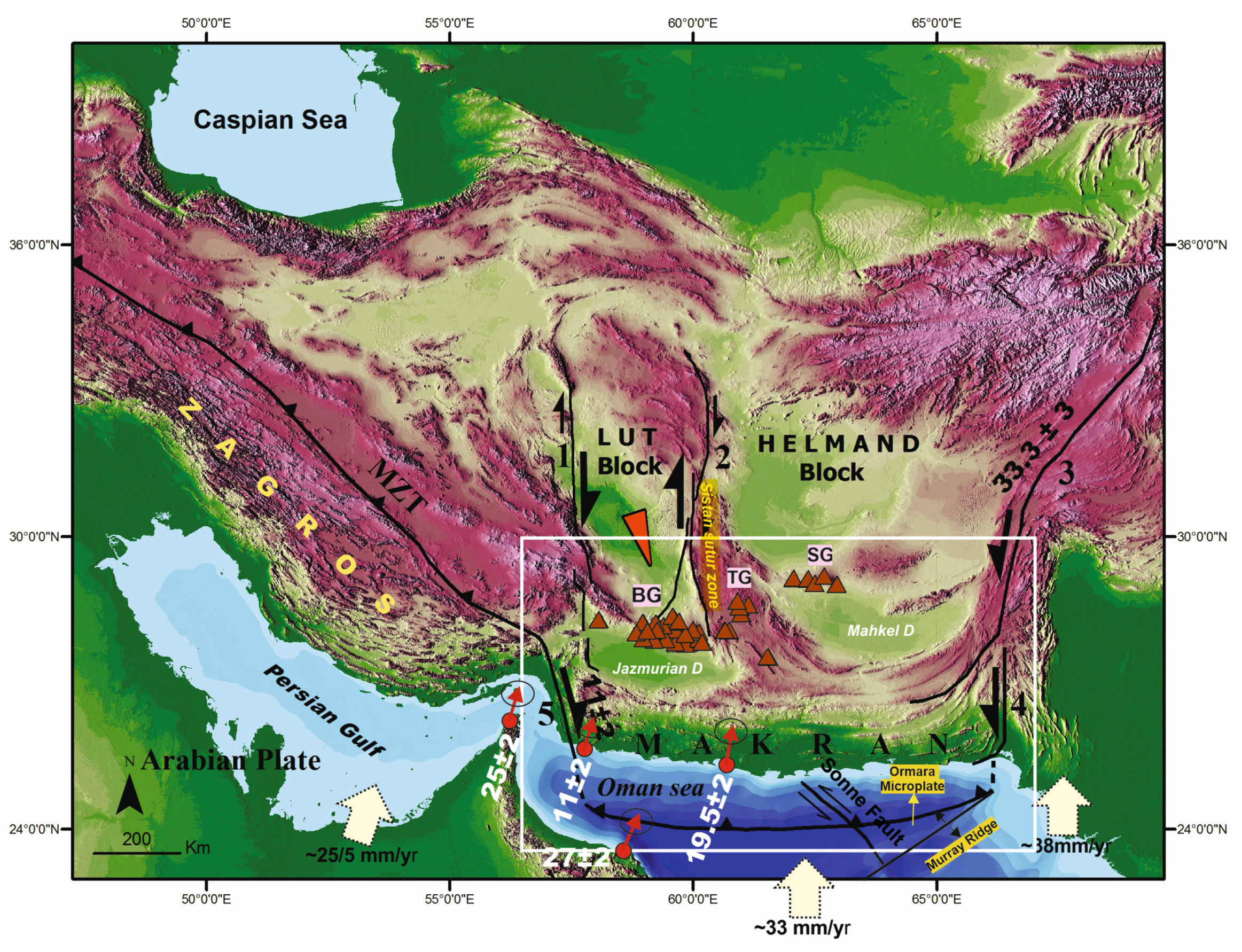


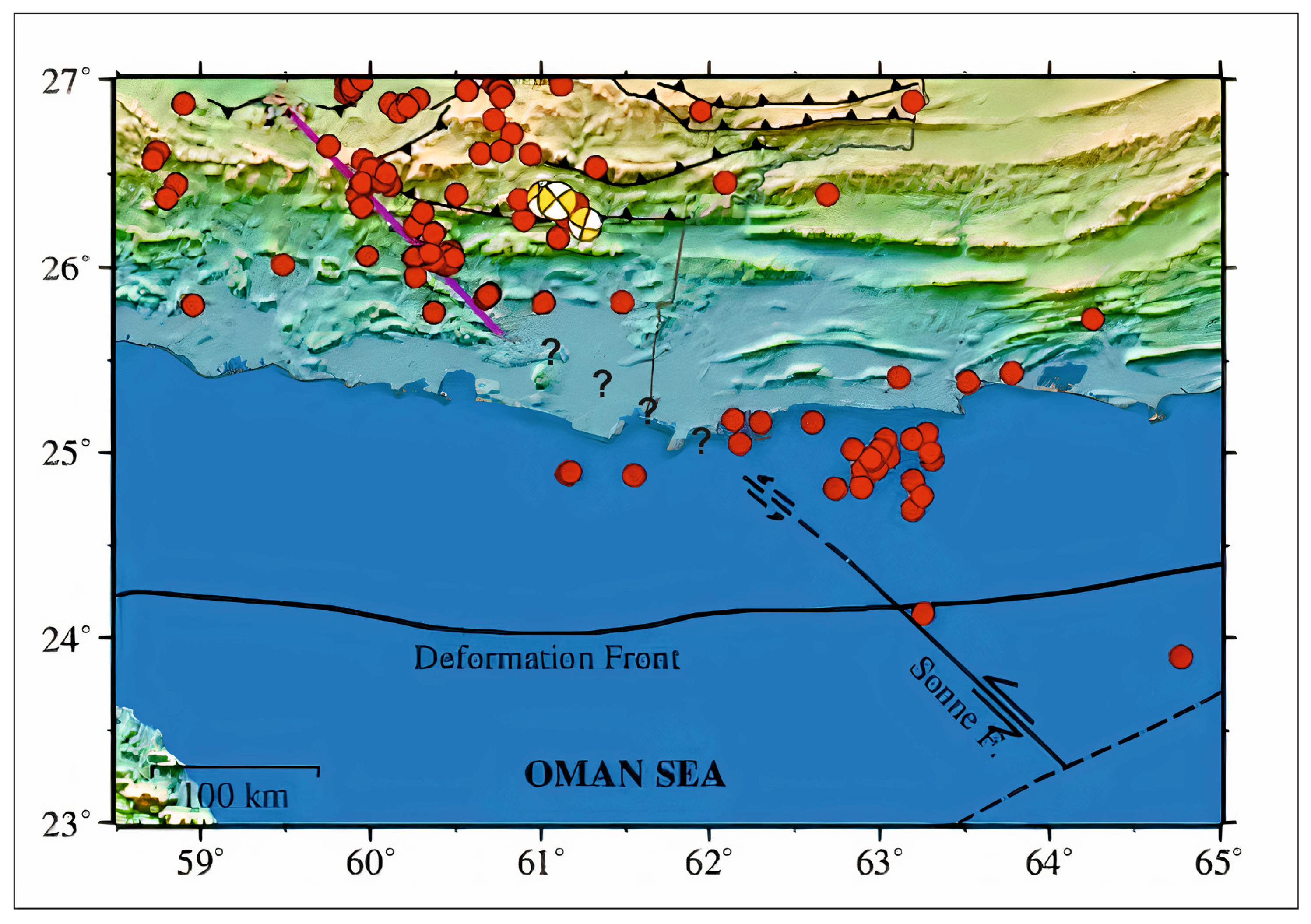
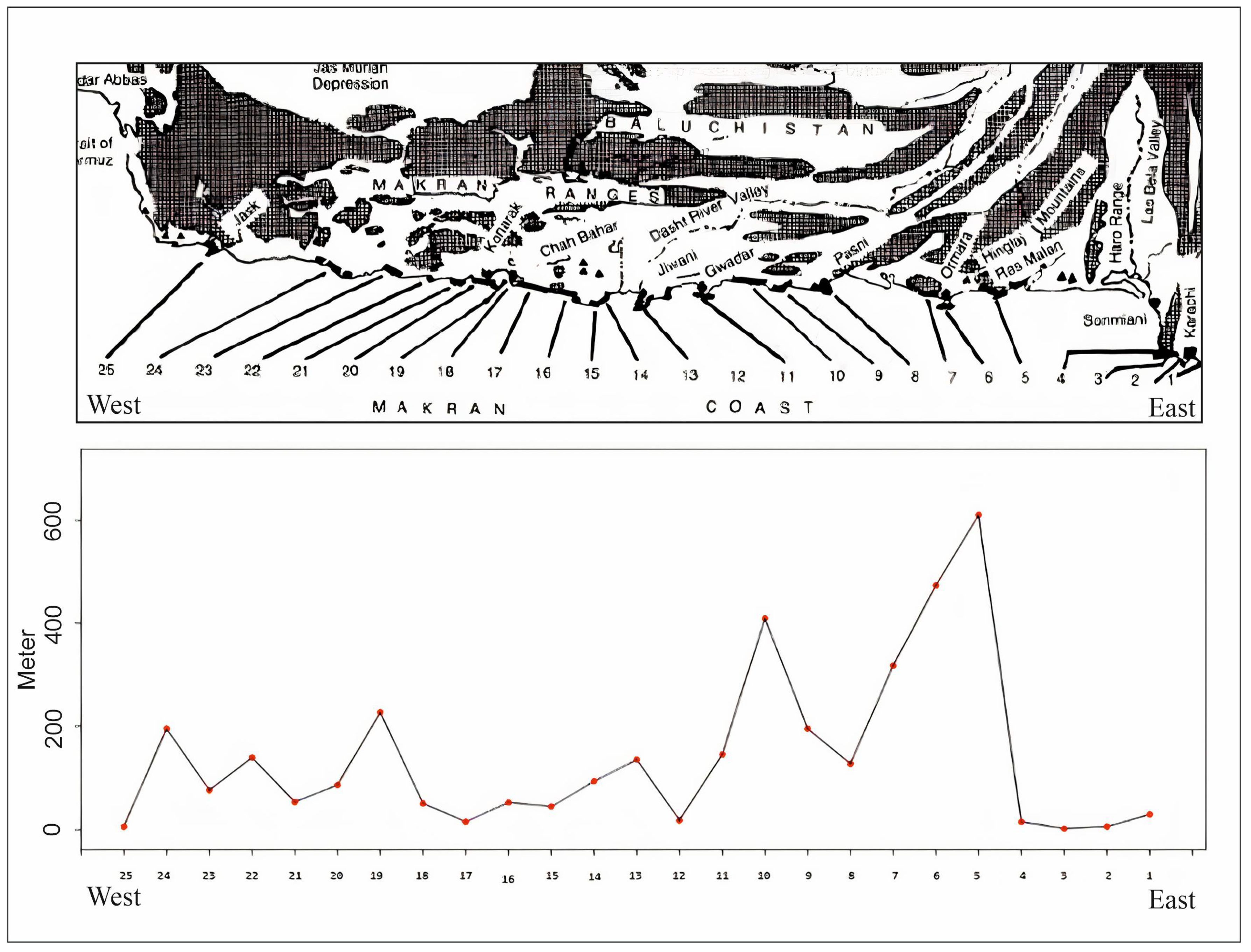

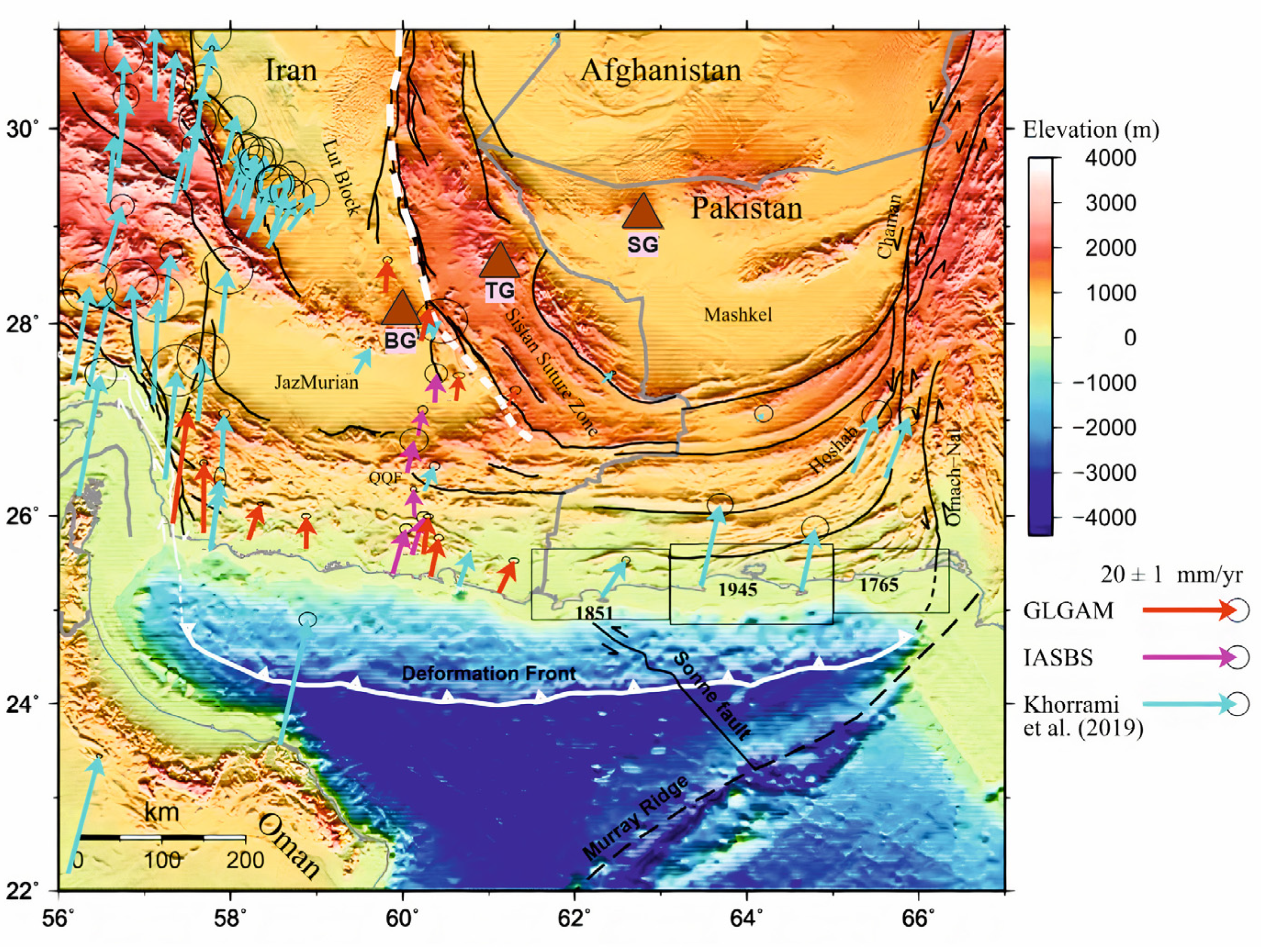
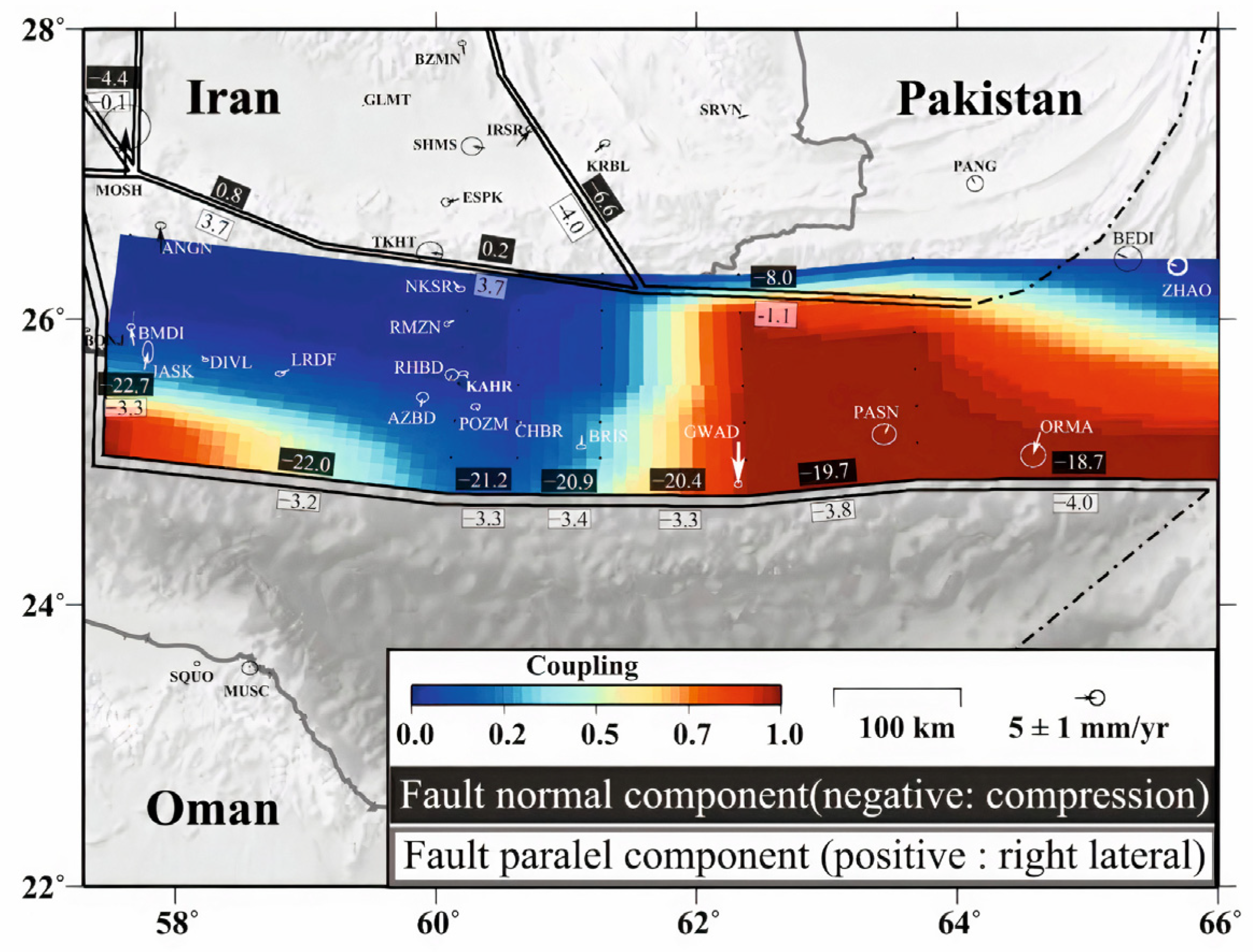
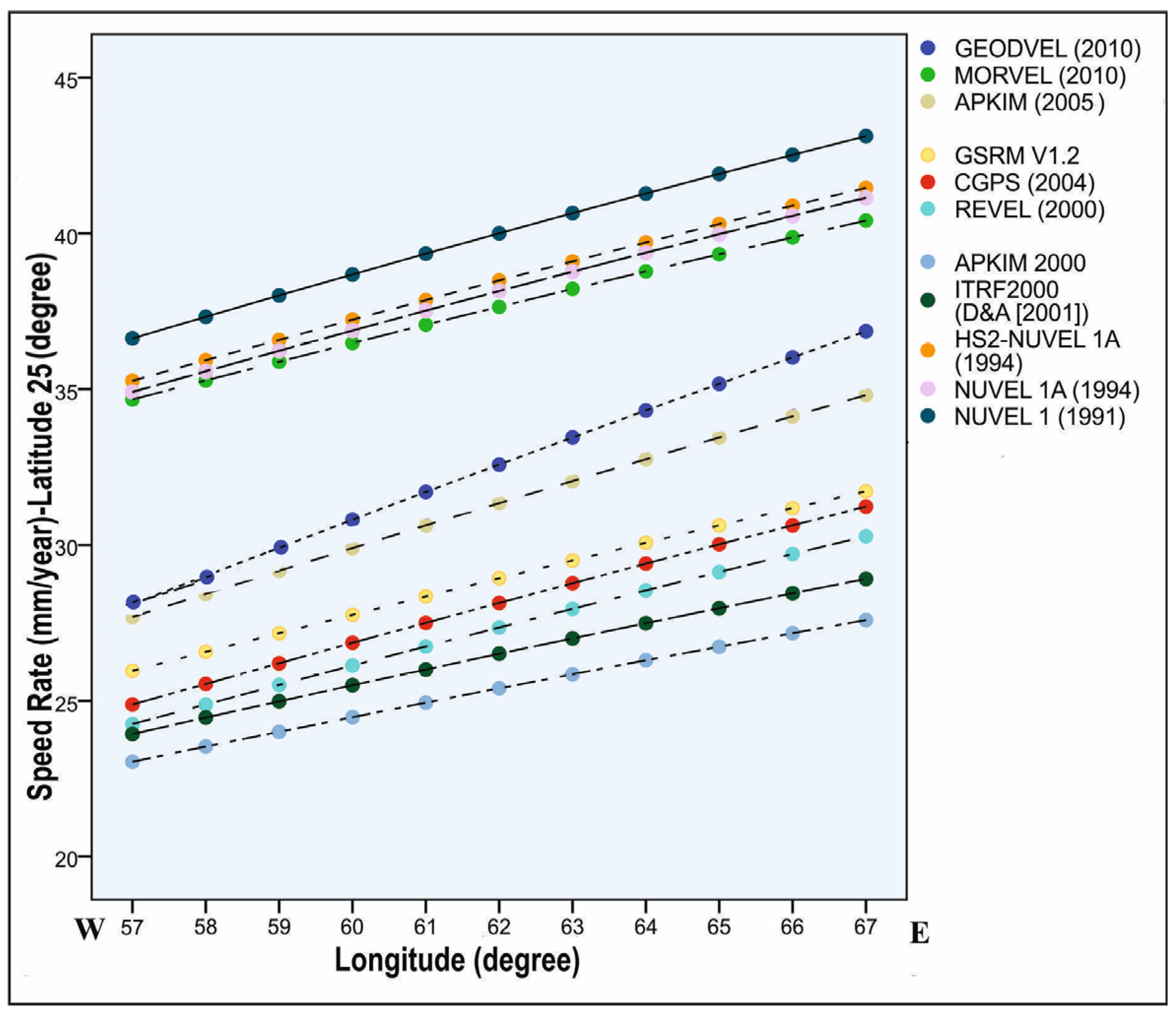
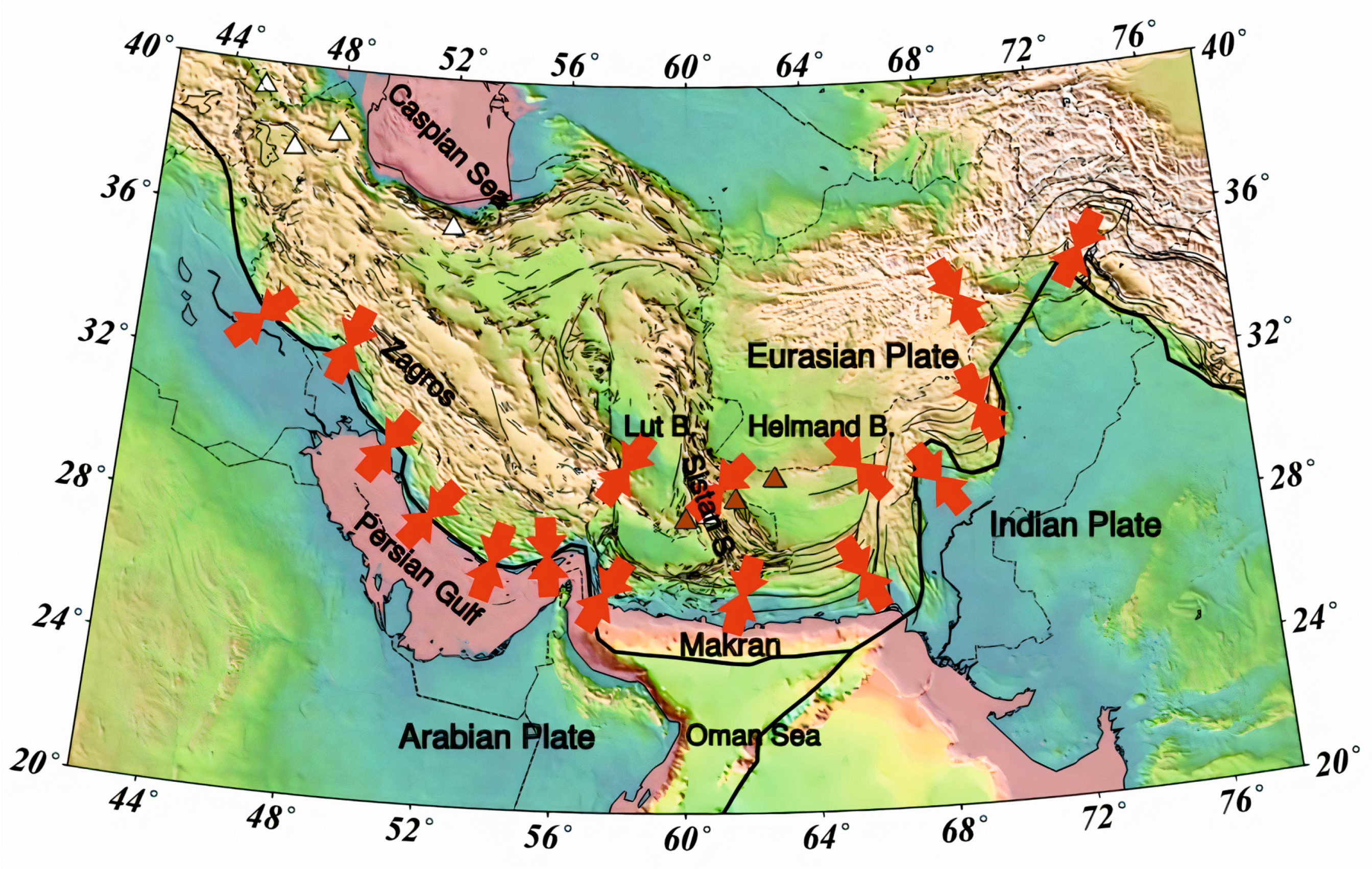

Disclaimer/Publisher’s Note: The statements, opinions and data contained in all publications are solely those of the individual author(s) and contributor(s) and not of MDPI and/or the editor(s). MDPI and/or the editor(s) disclaim responsibility for any injury to people or property resulting from any ideas, methods, instructions or products referred to in the content. |
© 2024 by the authors. Licensee MDPI, Basel, Switzerland. This article is an open access article distributed under the terms and conditions of the Creative Commons Attribution (CC BY) license (https://creativecommons.org/licenses/by/4.0/).
Share and Cite
Namdarsehat, P.; Milczarek, W.; Motavalli-Anbaran, S.-H.; Khaledzadeh, M. Makran Subduction Zone: A Review and Synthesis. Geosciences 2024, 14, 219. https://doi.org/10.3390/geosciences14080219
Namdarsehat P, Milczarek W, Motavalli-Anbaran S-H, Khaledzadeh M. Makran Subduction Zone: A Review and Synthesis. Geosciences. 2024; 14(8):219. https://doi.org/10.3390/geosciences14080219
Chicago/Turabian StyleNamdarsehat, Peyman, Wojciech Milczarek, Seyed-Hani Motavalli-Anbaran, and Matin Khaledzadeh. 2024. "Makran Subduction Zone: A Review and Synthesis" Geosciences 14, no. 8: 219. https://doi.org/10.3390/geosciences14080219
APA StyleNamdarsehat, P., Milczarek, W., Motavalli-Anbaran, S.-H., & Khaledzadeh, M. (2024). Makran Subduction Zone: A Review and Synthesis. Geosciences, 14(8), 219. https://doi.org/10.3390/geosciences14080219








